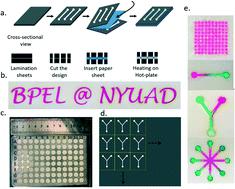Our official English website, www.x-mol.net, welcomes your
feedback! (Note: you will need to create a separate account there.)
Rapid and inexpensive process to fabricate paper based microfluidic devices using a cut and heat plastic lamination process
Lab on a Chip ( IF 6.1 ) Pub Date : 2022-07-08 , DOI: 10.1039/d2lc00452f Nityanand Kumawat 1 , Soja Saghar Soman 1 , Sanjairaj Vijayavenkataraman 1, 2 , Sunil Kumar 1, 2
Lab on a Chip ( IF 6.1 ) Pub Date : 2022-07-08 , DOI: 10.1039/d2lc00452f Nityanand Kumawat 1 , Soja Saghar Soman 1 , Sanjairaj Vijayavenkataraman 1, 2 , Sunil Kumar 1, 2
Affiliation

|
Microfluidic paper-based analytical devices (microPADs) are emerging as simple-to-use, low-cost point-of-care testing platforms. Such devices are mostly fabricated at present by creating hydrophobic barriers using wax or photoresist patterning on porous paper sheets. Even though devices fabricated using these methods are used and tested with a wide variety of analytes, still they pose many serious practical limitations for low-cost automated mass fabrication for their widespread applicability. We present an affordable and simple two-step process – cut and heat (CH-microPADs) – for the selective fabrication of hydrophilic channels and reservoirs on a wide variety of porous media such as tissue/printing/filter paper and cloth types, such as cotton and polyester, by a lamination process. The technique presents many advantages as compared to existing commonly used methods. The devices possess excellent mechanical strength against bending, folding and twisting, making them virtually unbreakable. They are structurally flexible and show good chemical resistance to various solvents, acids and bases, presenting widespread applicability in areas such as clinical diagnostics, biological sensing applications, food processing, and the chemical industry. Fabricated paper media 96 well-plate CH-microPAD configurations were tested for cell culture applications using mice embryonic fibroblasts and detection of proteins and enzymes using ELISA. With a simple two-step process and minimal human intervention, the technique presents a promising step towards mass fabrication of inexpensive disposable diagnostic devices for both resource-limited and developed regions.
中文翻译:

使用切割和热塑料层压工艺制造纸基微流体装置的快速且廉价的工艺
微流控纸质分析设备 (microPAD) 正在成为易于使用、低成本的即时检测平台。目前,此类器件大多是通过在多孔纸上使用蜡或光刻胶图案形成疏水屏障来制造的。尽管使用这些方法制造的设备被使用和测试了各种各样的分析物,但由于它们的广泛适用性,它们仍然对低成本自动化大规模制造造成了许多严重的实际限制。我们提出了一种经济实惠且简单的两步工艺 - 切割和加热 (CH-microPAD) - 用于在各种多孔介质(如纸巾/印刷纸/滤纸和布类型)上选择性制造亲水通道和水库,例如棉和聚酯,通过层压工艺。与现有的常用方法相比,该技术具有许多优点。这些设备具有出色的抗弯曲、折叠和扭曲的机械强度,使其几乎牢不可破。它们结构灵活,对各种溶剂、酸和碱具有良好的耐化学性,在临床诊断、生物传感应用、食品加工和化学工业等领域具有广泛的适用性。使用小鼠胚胎成纤维细胞对制造的纸介质 96 孔板 CH-microPAD 配置进行细胞培养应用测试,并使用 ELISA 检测蛋白质和酶。通过简单的两步过程和最少的人工干预,
更新日期:2022-07-08
中文翻译:

使用切割和热塑料层压工艺制造纸基微流体装置的快速且廉价的工艺
微流控纸质分析设备 (microPAD) 正在成为易于使用、低成本的即时检测平台。目前,此类器件大多是通过在多孔纸上使用蜡或光刻胶图案形成疏水屏障来制造的。尽管使用这些方法制造的设备被使用和测试了各种各样的分析物,但由于它们的广泛适用性,它们仍然对低成本自动化大规模制造造成了许多严重的实际限制。我们提出了一种经济实惠且简单的两步工艺 - 切割和加热 (CH-microPAD) - 用于在各种多孔介质(如纸巾/印刷纸/滤纸和布类型)上选择性制造亲水通道和水库,例如棉和聚酯,通过层压工艺。与现有的常用方法相比,该技术具有许多优点。这些设备具有出色的抗弯曲、折叠和扭曲的机械强度,使其几乎牢不可破。它们结构灵活,对各种溶剂、酸和碱具有良好的耐化学性,在临床诊断、生物传感应用、食品加工和化学工业等领域具有广泛的适用性。使用小鼠胚胎成纤维细胞对制造的纸介质 96 孔板 CH-microPAD 配置进行细胞培养应用测试,并使用 ELISA 检测蛋白质和酶。通过简单的两步过程和最少的人工干预,











































 京公网安备 11010802027423号
京公网安备 11010802027423号